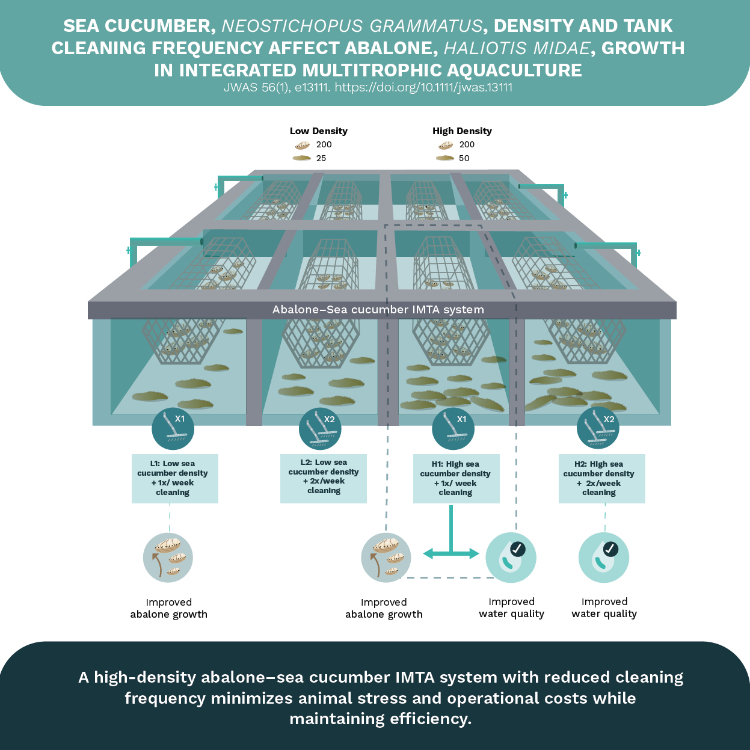JWAS Editor's Choice Awards 56(1)
The use of integrated multi-trophic aquaculture (IMTA) for multi-species culture is not new, but thi...

The use of integrated multi-trophic aquaculture (IMTA) for multi-species culture is not new, but this study looks at the potential of rearing sea cucumbers and abalone together as a tool for bioremediation and a way to stimulate increased abalone growth. To do this, the authors tested sea cucumber stocking density and tank cleaning frequency under IMTA and assessed growth, water, and sludge bioremediation. In this 16-week study four density treatments were tested. These included; 1) abalone co-cultured with a low-density of sea cucumbers - with tank cleaning once per week; 2) the same abalone low-density co-culture treatment with two tank cleanings per week; 3) abalone co-cultured with a high-density of sea cucumbers - with tanks cleaned once each week; and 4) the same abalone high-density co-culture treatment with tank cleanings twice per week. Results showed that nitrite levels were significantly lower when sea cucumbers were stocked at high densities. However, abalone cultured with a high or low density of sea cucumbers had higher mean weight and shell length when tanks were only cleaned once per week compared to greater cleaning frequency. Growth of sea cucumbers was not affected by cleaning frequency or density. The authors concluded that the high-density treatment combined with only one cleaning per week provided the best IMTA approach and promoted greater abalone growth and water bioremediation than other treatments. This study demonstrates the advantages of an abalone–sea cucumber IMTA system and highlights how stocking and cleaning frequency can affect growth and water quality. It also highlights the potential for cost savings and reduction of stress associated with a decreased need for tank cleaning through the incorporation of IMTA approaches to tank-based systems.
New artificial intelligence (AI) technologies to address a range of challenges are being introduced rapidly to the agriculture industry, and this literature review offers a comprehensive analysis of AI methods as they apply to aquaculture. The authors summarize how AI has been developed to assist producers with important tasks such as disease management, feed optimization, water quality monitoring, and stock and biomass predictions. Implementing automation or AI methodology within certain industry sectors has the potential of streamlining production and reducing costs. This review emphasizes that deep machine learning algorithms used for this methodology must be efficient within diverse aquaculture systems. Many methods that are being implemented promise to revolutionize aquaculture, but the authors have identified several gaps as well as opportunities for greater development and application of this technology. They noted that there is a need for varied data sets from different geographical regions and systems to enhance the accuracy of AI models. It is also important that protocols for data collection be standardized, and this review calls for future research to focus on the development of AI frameworks that take into account the integrated nature of an aquaculture operation. Overall, this review provides aquaculture producers and researchers with an overview of cutting-edge AI technologies and highlights the potential for innovative machine learning to improve management and contribute to the sustainable growth and development of the aquaculture industry.
With automation being developed in the industry, this paper presents a method for estimating fish growth in indoor tanks that could reduce handling stress, save time, and reduce labor costs for producers. In this study, olive flounder (Paralichthys olivaceus) were reared in indoor tank systems and a visual-information-based method was implemented that utilized a two camera system and a light-emitting- diode (LED) grid to measure flounder length. By converting the data to centimeters based on a pre-built dataset, the captured images could be used to calculate the average length of each fish. An algorithm was then implemented that allowed overall length of each fish to be determined. The study was effective due to the methodology and the accuracy of the length-weight model that allowed highly accurate body weight to be estimated for each flounder based on length. This method produced rapid results, was user-friendly, and the findings highlight how such technology can be implemented effectively for specific fish species.